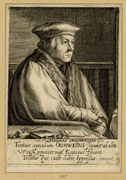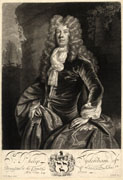Portraits
 Portrait prints were the commonest
type of print throughout the period. The earliest date from the Tudor period, and are
disproportionately of monarchs and members of the aristocracy, though there are also some of
seafarers like Drake. In the early Stuart period, monarchs and courtiers are comparably
dominant as far as single sheet prints are concerned, though there is also the start of a
more representative coverage, represented particularly by the compilation Herωologia, which included portraits of leading Englishmen in various walks of life.
All of these are well represented in our database. In the period of the Civil War there was
a demand for portraits of celebrities for which a dealer like Peter Stent catered, and this
continued into the Restoration. The Restoration saw a crucial development, however, in the
Portrait prints were the commonest
type of print throughout the period. The earliest date from the Tudor period, and are
disproportionately of monarchs and members of the aristocracy, though there are also some of
seafarers like Drake. In the early Stuart period, monarchs and courtiers are comparably
dominant as far as single sheet prints are concerned, though there is also the start of a
more representative coverage, represented particularly by the compilation Herωologia, which included portraits of leading Englishmen in various walks of life.
All of these are well represented in our database. In the period of the Civil War there was
a demand for portraits of celebrities for which a dealer like Peter Stent catered, and this
continued into the Restoration. The Restoration saw a crucial development, however, in the
 form of the introduction of
mezzotint, which was predominantly used for portraiture. The bpi1700 database contains many
examples of such portraits, not least by John Smith, who was to become the leading
mezzotinter for nearly half a century until his death in 1743.
form of the introduction of
mezzotint, which was predominantly used for portraiture. The bpi1700 database contains many
examples of such portraits, not least by John Smith, who was to become the leading
mezzotinter for nearly half a century until his death in 1743.
As for the purposes that such portrait prints served, this is indicated by their range, from large, single sheet prints intended as memorials of the person depicted to smaller plates, often intended for insertion in books by or about the figure in question. It seems likely that the larger ones were often hung up on the walls of houses, probably coated with varnish, though almost by definition those treated in this way have not survived. Smaller ones, however, were often pasted into books or albums, and a handful of such albums survive, including those of Samuel Pepys, preserved at Magdalene College, Cambridge, and that kept by the Somerset landowner, M.P. and virtuoso, Sir Philip Sydenham, which is now in the Department of Prints and Drawings at the British Museum.